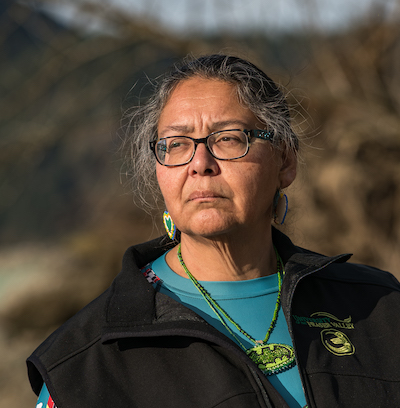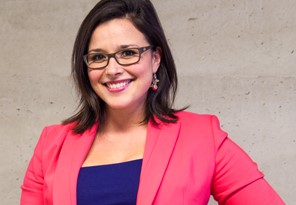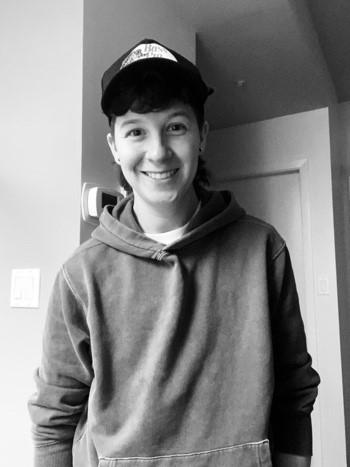
Wednesday, March 29 | 12:00PM – 1:00PM
Panelists

Shirley Anne Swelchalot qas te Shxwha:yathel Hardman, M.Ed.
Shirley Anne Swelchalot qas te Shxwha:yathel Hardman is a doctoral candidate at UBC and the recipient of a SSHRC Doctoral Scholarship. She is immersed in the work of Indigenizing, and, more recently, has become engaged in Reconciliation education. Recognizing the potential of colonialism to influence technological forms, she argues that it is imperative that we identify technology as useful in cultural expression and in educational policy and practice. However, she asserts that this must be done on Indigenous terms, guided by Indigenous goals of self-determination and well-being. Shirley believes that each one of us has a gift given to us by our ancestors. She believes that we must honor our gifts. It is because of these beliefs that she pursues education and resurgence for Indigenous people.

Amber Shilling, PhD
Dr. Amber Shilling is Anishinaabekwe from Mnjikaning First Nation. She completed her Ph.D. at the University of British Columbia which explored how urban Indigenous youth utilize technology to engage with culture, language, and identity. Her research demonstrates that youth are incredibly skilled, knowledgeable of risks in the digital age, and enthusiastic contributors to the development of cultural resources. Dr. Shilling is highly skilled in the areas of Indigenizing, decolonizing, and grappling with the complexities of truth and reconciling.

Lou (Megan) Hill, BA student
Lou is Peguis Cree and a 2nd-year mature student at UBC in the BA program Majoring in Indigenous Studies. Lou returned to post-secondary at Langara College to upgrade her high school courses. In 2021, she transferred to the UBC Arts program to complete the required courses to apply for Dental school. Lou is currently completing her final semester and will apply for UBC’s 2024 Dentistry program this summer. Lou is here today to share her experiences navigating post-secondary as a 1st generation, Two-spirit First Nations student living with ADHD, PTSD, and generalized anxiety, and working towards her goal of becoming a Dentist. Though unconventional, Lou hopes to share how her identity has contributed to her sense of belonging and understanding of westernized education.
Facilitators
Jamilee Baroud, Curriculum and Evaluation Consultant, ETS
Amir Doroudian, Learning Designer, ETS
Summary
In this interactive Viewpoints session “Indigeneity Accessibility And Technology”, we aimed to question, challenge, and complicate the myriad ways that accessibility and technology intersect with decolonizing education, and engaged with a variety of strategies and pathways to create a more accessible future. Our panelists, Shirley Hardman, M.Ed., Amber Shilling, PhD., and Megan Hill, BA student, shared their unique perspectives, research, and approaches to equitably improve the educational experiences of indigenous students.
Opening
The session started with Megan (Lou) who shared that her experiences as a post-secondary student navigating the various hurdles of Western education impacted her and her identity as an indigenous, white-presenting, two-spirited student living with generalized anxiety and ADHD.
She noted that in the past, she would refer to her intersectional identities as hurdles that needed to be overcome, and it was difficult to believe that she deserved to belong in higher education. She later realized not only that her identities were gifts allowing her to better understand and embrace herself, but that it was the institution that needed to recognize their role in perpetuating inequities and provide adequate supports. Megan concluded by arguing that by listening to and learning from Indigenous narratives, those working in post-secondary institutions can acknowledge diverse Indigenous experiences and understand the courage it takes to be at the institution each day. Instead of allowing indigenous perspectives in education to be overlooked, she encourages everyone to think about what could be done to make each classroom or department safe and more inclusive.
After Megan’s compelling story, Shirley and Amber discussed several important intersections of Indigeneity, Accessibility and Technology. What follows are the themes that emerged from their discussion.
Discussion themes
Understanding the intersections of education, technology, and indigenous people calls for examining aspects of globalization, education policies, and practices involving diverse communities. By examining colonialism, we can see how indigenous people challenge and use digital elements for self-expression and political mobilization. Technology has played a crucial role in providing distance learning and preserving indigenous languages and cultures. However, there are concerns about the protection of cultural property, indigenous knowledge systems, and the need to resist hegemony in knowledge production. It is essential to engage in self-reflection and recognize that indigenous people in Canada have faced invasion by various colonizers, including missionaries, government agents, and academics, all of which have had damaging consequences.
Shirley referred to Murray Sinclair, Canadian Indigenous leader, lawyer, and advocate for Indigenous rights, to highlight that an ongoing colonial foundation of education that has resulted in historical amnesia regarding indigenous people. This amnesia has left a dark legacy of exploitation, poverty, cultural dislocation, and residential school abuses. As cited by Shirley, Sinclair urges individuals to self-reflect and recognize their role in this colonial history and better understand indigenous people’s pursuit of self-determination and well-being.
The internet is an exceedingly deceptive technology whose power is immensely attractive to American Indians, but until a universalistic and individualistic foundation is restructured to incorporate spatial, social, spiritual, and experiential dimensions, cyberspace is no place for tribalism. While technology can be perceived as culturally neutral, it may inadvertently reinforce cultural transformation patterns like those of the industrial revolution. Indigenous people rely on relationships and interconnectedness in learning, which current technology may struggle to accommodate.
“Indigenous pedagogies demand that we learn from each other, we learn from the land, plants, trees, animals, the water, the waterways, and from the sky, and the stories about these. The stories connect us to the past and to the future. How technology can work with us to achieve this? That is what we need to grapple with.” – Shirley Anne Swelchalot Hardman
In addressing the importance of indigenous education, it is important to recognize that everyone has a responsibility, including educators, administrators, students, and leaders. Often, students come to universities unaware of the culturally-encoded reality that excludes indigenous perspectives and ways of life. Higher education institutions tend to reproduce imperial and colonial structures, teaching curricula that perpetuate stereotypes and privilege a single way of knowing, resulting in barriers to form respectful relationships with indigenous peoples. To counteract this, all of us need to make efforts to actively engage in decolonizing and indigenizing, so we can create a more inclusive educational environment that promotes understanding of, and respect for, indigenous peoples and their communities.
“Decolonizing, as well as indigenizing, asks us to unlearn and relearn histories, confront colonial ideologies, and embed indigenous ways of knowing and viewing the world into everything we do. Recognize the place where we are more than reciting the names on the map. Each of us has a responsibility to embrace a critical understanding of decolonization and appreciate the self-determination of the indigenous people and their communities.” – Shirley Anne Swelchalot Hardman
Amber started her speech by emphasizing the evolving nature of the concept of indigeneity. She then referred to the idea of the cultural interface by Martin Nakota. Cultural interface acknowledges the existence of conflicting ideas that coexist and are connected to indigeneity. This idea resonated with the way indigenous knowledge and teachings allow for multiple perspectives, even those in opposition, to coexist. The cultural interface also relates to the way technology represents a different world and space for indigenous people: not recognizing the way people exist in the online world does not invalidate their identity. Amber also discussed the issue of physical access to technology and the privilege it entails, and emphasized the need to be mindful of systemic and structural racism that limits access to technology and the privilege each person has in varying capacities.
Although there is some overlap between the two concepts, they are different. Intersectionality is all of those components in your identity that make you who you are. Cultural interface, on the other hand, represents a space where multiple people coexist, each with their unique intersectional identities. These identities may overlap or conflict. Cultural interface allows for their co-existence. When envisioning cultural interface, it might be helpful to think of it as constellations.
We need to establish a strong connection to our surroundings and gain a deeper understanding of the places and people around us, beyond just knowing their names. By recognizing our location and cultivating connections to it, we can start to appreciate the diverse aspects of various indigenous cultures. We need to link our learning to a specific location and recognize the origins and context of the information being shared, as well as the people it represents.
A few resources were also made available prior to the session.
- Andreotti, V., Stein, S., Ahenakew, C., & Hunt, D. (2015). Mapping interpretations of decolonization in the context of higher education. Decolonization: Indigeneity, Education & Society, 4(1), 21-40.
- Risling Baldy, C. (2021) Radical relationality in the Native Twitterverse: Indigenous women, Indigenous feminisms, and (re)writing/(re)righting resistance on #nativetwitter. In Indigenous peoples rise up: The global ascendency of social media activism. (Eds.) Carlson, B., Berglund, J., & Walter de Gruyter & Co., Rutgers University Press. (125-139)
Baldy (2021) investigates Indigenous women’s voices and activism on social media. She argues that Indigenous women’s social media activism serves as a space for ongoing Indigenous resistance, survivance, and representation. These forms of activism are important because they urge us to resist and question colonialism and white supremacy and better understand how it informs social media, law, policy, and political status. Social media has become a space to (re)claim presence, to present for each other and to find ways to sustain culture outside the margins.
- Bartlett, A. N., & Freeze, B. T. (2019). Assess, Sort, Classify: “Othering” of Indigenous Students in Manitoba’s Schools. Exceptionality Education International, 29(2), 91–109.
- Rice, C., Dion, D. S., & Chandler, E. (2021). Decolonizing Disability Through Activist Art. Disability Studies Quarterly, 1-26.
Rice, Dion and Chandler (2021) utilize activist art from their 2018-19 project titled, Bodies in Translation: Activist Art, Technology and Access to Life to work to decolonize disability in ways that are resonant with Indigenous perspectives and worldviews. The purpose is to recuperate Indigenous bodymind concepts that radically differ from and often reject colonial understandings of abnormality and to challenge the effects of colonial systems that debilitate Indigenous nations and bodies. The authors argue that art can support us to think beyond the binary of mind and body, move away from deficit-based models of disability, reclaim knowledge of and about our bodies, and question colonial facts and concepts of disability as a way to recuperate Indigenous ways of knowing.
- Shilling, A. J. (2020). Chapter 5: Re-storying the Sky (Discussion). Exploring the use of mobile language learning technology as a means for urban Indigenous youth to connect to identity and culture (T). University of British Columbia. (118-128)
Shilling’s (2020) study draws on Indigenous methodology and Anishinaabe teachings to engage urban Indigenous youth in sharing circles and one-on-one conversations to understand how technology use connects to their culture, identity, and language. Participants shared ideas on how to reach urban Indigenous youth while protecting Indigenous knowledge and minimizing costs to communities. Of primary importance to urban Indigenous youth is an increased focus on social media and technology as a way to build and maintain relationships with knowledge-keepers and community members and engage in language and cultural learning opportunities.
- Risling Baldy, C. (2021) Radical relationality in the Native Twitterverse: Indigenous women, Indigenous feminisims, and (re)writing/(re)righting resistance on #nativetwitter. In Indigenous peoples rise up: The global ascendency of social media activism. (Eds.) Carlson, B., Berglund, J., & Walter de Gruyter & Co., Rutgers University Press. (125-139)
- Yee, L. N., & Butler, L. D. (2022). Decolonizing Possibilities in Special Education Services. Canadian Journal of Education / Revue canadienne de l’éducation, 43(4), 1071-1103.
Yee and Butler (2022) argue that colonialism has created environments where Indigenous children are more likely to develop disabilities, and because of biased assessments and the absence of cultural understanding, students are often diagnosed with a disability that may not exist. Also, colonial influences that overlook Indigenous perspectives inside schools may cultivate student behaviours commonly associated with disabilities. Unfortunately, special education instruction and support are often compliant with colonial narratives instead of critical thought and cognitive development. Yee and Butler suggest that to decolonize special education, educators can engage in critical self-reflection, build a relationship with Indigenous perspectives and layer them into their teaching, and integrate holistic assessment measures and teaching practices, not only to prevent misdiagnoses but also to speak to and address the needs of Indigenous students’ behavioural challenges.
Equity, Diversity, and Inclusion (EDI)

This event is a part of our Equity, Diversity, and Inclusion (EDI) initiative, which aims to raise awareness of EDI topics particularly accessibility in in-person, online and hybrid courses in line with the coming new provincial accessibility guidelines. Learn more about our related events and resources.